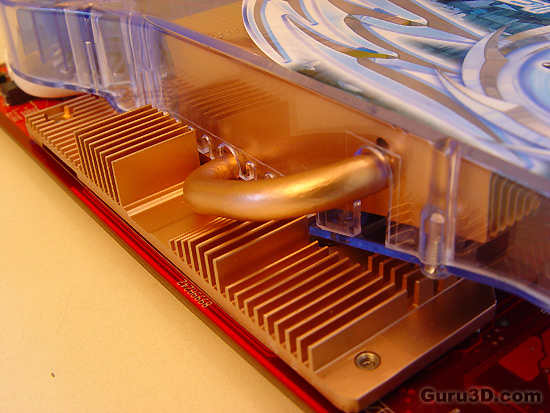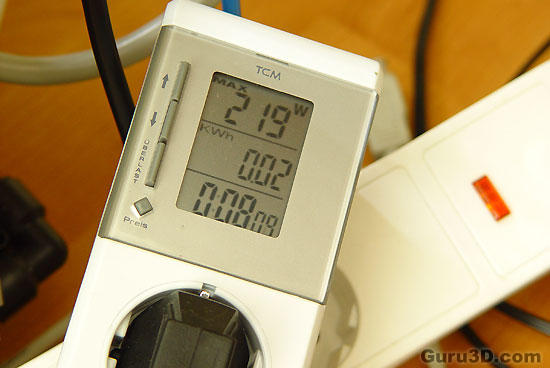Page 3
How cool is that ?
New on the X1950 Pro is the third generation of ICeQ cooling. It's a great heatpipe/active fan combination in the IceQ style that we all learned to know and love. It does it's job very sufficiently and most of all, is a very quiet solution.
 New ICEQ3 cooling is now heatpipe based.
New ICEQ3 cooling is now heatpipe based.
The design itself is large, yet nice to look at. The plastic coating is VERY UV reactive as we'll show you. Which brings a very nice touch to the PCs looks.
Heatpipe design is however all about silence and that translates itself to heat. In our findings the new IceQ3 cooler is not at all much cooler than the reference cooler from ATI itself, it's a heap more quiet though and you can expect temperatures ranging from ~40 degrees C in idle up-to 59 Degrees C at 100% load which is just really good..
Noise Levels coming from the graphics card
When graphics cards produce a lot of heat, usually that heat needs to be transported away from the hot core as fast as possible. Often you'll see massive active fan solutions that can indeed get rid of the heat, yet all the fans these days make the PC a noisy son of a gun. I'm doing a little try out today with noise monitoring, so basically the test we do is extremely subjective. We bought a certified dBA meter and will start measuring how many dBA originate from the PC. Why is this subjective you ask? Well, there is always noise in the background, from the streets, from the HD, PSU fan etc etc, so this is by a mile or two not a precise measurement. You could only achieve objective measurement in a sound test chamber.
The human hearing system has different sensitivities at different frequencies. This means that the perception of noise is not at all equal at every frequency. Noise with significant measured levels (in dB) at high or low frequencies will not be as annoying as it would be when its energy is concentrated in the middle frequencies. In other words, the measured noise levels in dB will not reflect the actual human perception of the loudness of the noise. That's why we measure the dBa level. A specific circuit is added to the sound level meter to correct its reading in regard to this concept. This reading is the noise level in dBA. The letter A is added to indicate the correction that was made in the measurement. Frequencies below 1kHz and above 6kHz are attenuated, where as frequencies between 1kHz and 6kHz are amplified by the A weighting.
|
|||||||||||||||||||||||||||||||||||||||||
We startup a benchmark and leave it running for a while. The fan starts to rotate faster and makes a moderate noise. We take the dBA meter, move away 75 CM and then aim the device at the active fan on the graphics card. We measure roughly 43 dBa which is to be considered a quiet noise level coming from the PC yet also a norm as most of our tests end up at this sound level. Again, this is a very subjective test and that dBa level includes all noise in the environment.
Le 4ème pouvoir "The Fourth Power"
What we always do with new graphics cards is we measure the wattage peak with the help of a wattage meter. Slight side note, you are looking at the overall usage of the entire PC. The meter is placed between the power connector and the PSU. So please understand that using a Wattage meter is not the most reliable way of measuring power consumption. This is how much power is being consumed, taking the measurement from the wall socket, and you need to look at the results as being an indication and not an exact science.
Let's have a look at some X1000 products and specifically the X1650 XT & X1950 Pro products in regards to total PC power consumption:
|
||||||||||||||||||||||||||||||||
The methodology is simple: we look at the peak wattage during a 3DMark05 session to verify power consumption. You are not looking at the power consumption of the graphics card, but the consumption of the entire PC. What is really interesting to see is that the new 80nm production obviously allows less voltage and thus usage in the graphics core. The X1950 Pro was only marginally higher over the reference model due to it's slightly higher clocks speed.
I suggest you use a 420 Watt PSU minimum, but better is always recommended especially if you keep SLI or Crossfire in mind as a future upgrade. When you buy a new PSU then look at the packaging and check the 12 volts rail for the amperage, 20 AMPS should be fine for a single card, 30 for Crossfire (in this segment). With the X1950 Pro in Crossfire I'd recommend a 520 Watts PSU though.
Here are some indications on what would happen if your PSU can't cope with the load:
- unusual, fluctuating 3D gaming performance
- games crashing
- spontaneous resetting of the PC
- freezes during gameplay
- PSU overload can cause it to break down or shut down.

